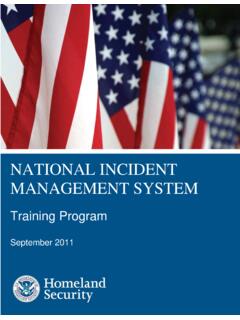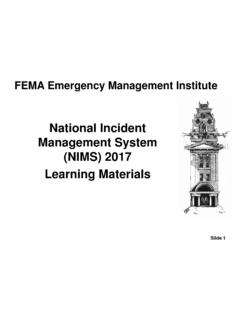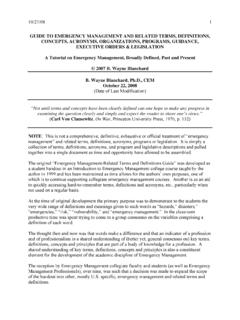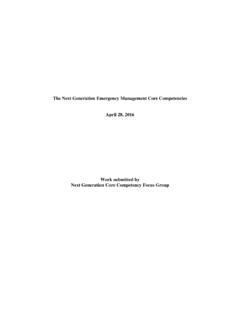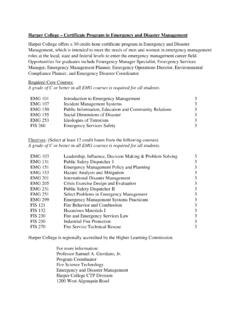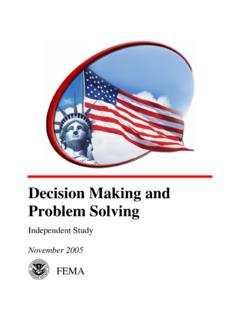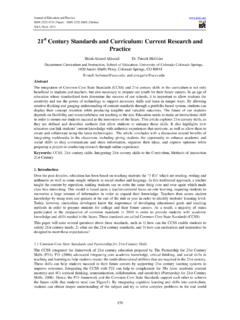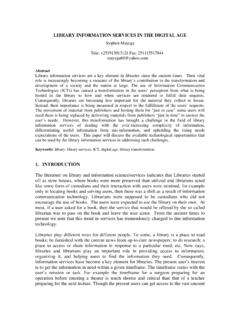Transcription of Civil Defense and Homeland Security: A Short History of ...
1 1 Civil Defense and Homeland Security: A Short History of National Preparedness Efforts September 2006 Homeland Security National Preparedness Task Force 2 Civil Defense and Homeland Security: A Short History of National Preparedness Efforts September 2006 Homeland Security National Preparedness Task Force 3 ABOUT THIS REPORT This report is the result of a requirement by the Director of the Department of Homeland Security s National Preparedness Task Force to examine the History of national preparedness efforts in the United States. The report provides a concise and accessible historical overview of national preparedness efforts since World War I, identifying and analyzing key policy efforts, drivers of change, and lessons learned.
2 While the report provides much critical information, it is not meant to be a substitute for more comprehensive historical and analytical treatments. It is hoped that the report will be an informative and useful resource for policymakers, those individuals interested in the History of what is today known as Homeland security, and Homeland security stakeholders responsible for the development and implementation of effective national preparedness policies and programs. 4 Introduction From the air raid warning and plane spotting activities of the Office of Civil Defense in the 1940s, to the Duck and Cover film strips and backyard shelters of the 1950s, to today s all-hazards preparedness programs led by the Department of Homeland Security, Federal strategies to enhance the nation s preparedness for disaster and attack have evolved over the course of the 20th century and into the 21st .
3 Presidential administrations can have a powerful impact on both national and citizen preparedness. By recommending funding levels, creating new policies, and implementing new programs; successive administrations have adapted preparedness efforts to align with changing domestic priorities and foreign policy goals. They have also instituted administrative reorganizations that reflected their preference for consolidated or dispersed Civil Defense and Homeland security responsibilities within the Federal government. Programs were seldom able to get ahead of world events, and were ultimately challenged in their ability to answer the public s need for protection from threats due to bureaucratic turbulence created by frequent reorganization, shifting funding priorities, and varying levels of support by senior policymakers.
4 This in turn has had an effect on the public s perception of national preparedness. Public awareness and support have waxed and waned over the years, as the government s emphasis on national preparedness has shifted. An analysis of the History of Civil Defense and Homeland security programs in the United States clearly indicates that to be considered successful, national preparedness programs must be long in their reach yet cost effective. They must also be appropriately tailored to the Nation s diverse communities, be carefully planned, capable of quickly providing pertinent information to the populace about imminent threats, and able to convey risk without creating unnecessary alarm.
5 The following narrative identifies some of the key trends, drivers of change, and lessons learned in the History of national preparedness programs. A review of the History of these programs will assist the Federal government in its efforts to develop and implement effective Homeland security policy and better understand previous national preparedness initiatives. Pre-Cold War Period (1917-1945) World War I introduced a new type of attack: the use of strategic aerial strikes against an enemy s population to degrade its ability and will to wage war. German aerial bombardment of towns in countries such as France, Belgium, and Poland began in August 1914, and in the following year Kaiser Wilhelm authorized sustained bombing campaigns against military and civilian targets, particularly against From May through October of 1915, Germany launched seven air strikes against London England, like most other nations at the time, did not have an organized Civil Defense program to aid citizens during such attacks.
6 Individuals were forced to find their own way to safety, often taking refuge in the city s underground subway By all assessments, the damage and casualty figures that resulted from these early bombing operations were comparatively insignificant, but they exerted a psychological toll on the British It became clear that civilian Defense , involving a range of actions to protect the general public in the event of attack, would become a major fixture in future warfare. 5 Though the Axis and Allied powers continued to employ strategic bombing throughout World War I, leaders in the United States did not feel that the country was vulnerable to attack. They concentrated their public outreach on rallying support for the war Much of this task was coordinated by the Council of National Defense , established on August 29, 1916 with the passage of an Army appropriations The Council was a presidential advisory board that included the Secretaries of War, Navy, Interior, Agriculture, Commerce, and Labor; assisted by an Advisory Committee appointed by the Its responsibilities included coordinating resources and industries for national Defense and stimulating civilian morale.
7 8 The work of the Council escalated when the United States entered the war in 1917. In the same year, the Federal government asked State governors to create their own local councils of Defense to support the National However, the Council s activities continued to focus more on facilitating mobilization for the war than on protecting civilian resources. When hostilities ended, the Council shifted its efforts toward demobilization. Its operations were suspended in June, For the remainder of the 1920s, the Federal government undertook little public outreach related to Defense and security. However, the 1930s saw a revival of Civil Defense efforts, when aggressive actions and arms stockpiling in Europe fueled international In 1933, President Franklin Roosevelt created by executive order the National Emergency Council (NEC) which consisted of the President, his Cabinet members, and the head of nearly every major Federal agency, commission, and The mission of the NEC included a variety of programs unrelated to Civil Defense .
8 However, its duties also included coordination of emergency programs among all agencies involved in national As World War II ignited in Europe, Roosevelt reestablished the Council of National Defense in Once again States were asked to establish local counterpart councils. Tensions among Federal, State and local governments began to rise about authority and resources. The states claimed they were not given enough power to manage Civil Defense tasks in their own jurisdictions, and local governments asserted that State governments did not give urban areas proper consideration and Non-attack disaster preparedness remained almost entirely the responsibility of States, while federal funding was reserved primarily for attack preparedness.
9 Because of extensive civilian bombing campaigns in Europe, concerns about possible attacks against the Homeland increased. Mayor Fiorello La Guardia of New York City wrote a letter to President Roosevelt stating: There is a need for a strong Federal Department to coordinate activities, and not only to coordinate but to initiate and get things going. Please bear in mind that up to this war and never in our History , has the civilian population been exposed to attack. The new technique of war has created the necessity for developing new techniques of civilian Defense .16 President Roosevelt responded to the increasing concern of the public and local officials by creating the Office of Civilian Defense (OCD) in The President delegated a number of responsibilities to the OCD by broadly interpreting civilian protection to include morale maintenance, promotion of volunteer involvement, and nutrition and physical The OCD oversaw unprecedented federal involvement 6 in attack preparedness.
10 As with the Council of National Defense , the OCD created corresponding Defense councils at the local The issue of whether the OCD should emphasize protective services, typically done at that time by men, or social welfare services, typically undertaken at that time by women, created tension from the office s Director Fiorello LaGuardia referred to nonprotective activities as sissy stuff and saw opportunities to build neighborhood militias. Pressured to focus on other nonprotective areas such as neighborhood support, he appointed Eleanor Roosevelt to expand volunteer The two leaders, with their radically divergent points of view, exemplified a conflict over the meaning and purpose of Civil Defense that would continue well into the cold war era.

